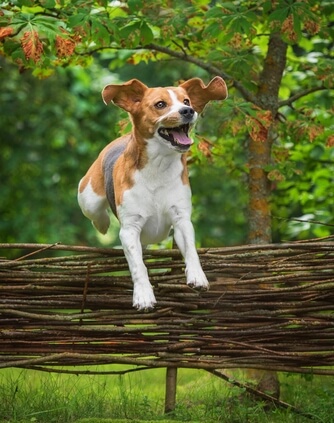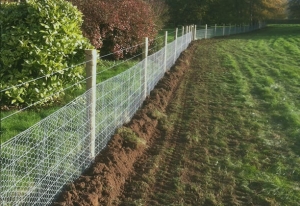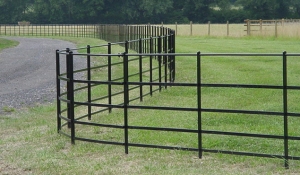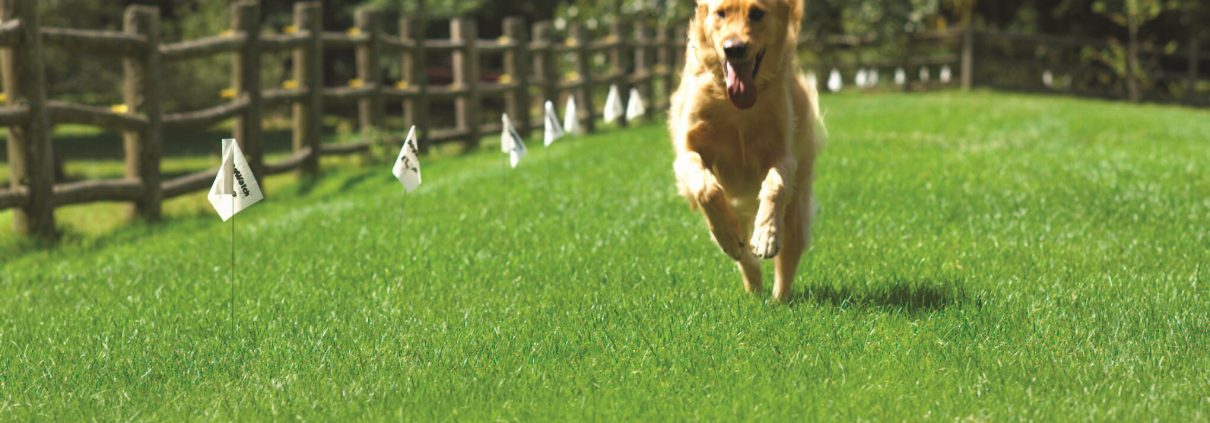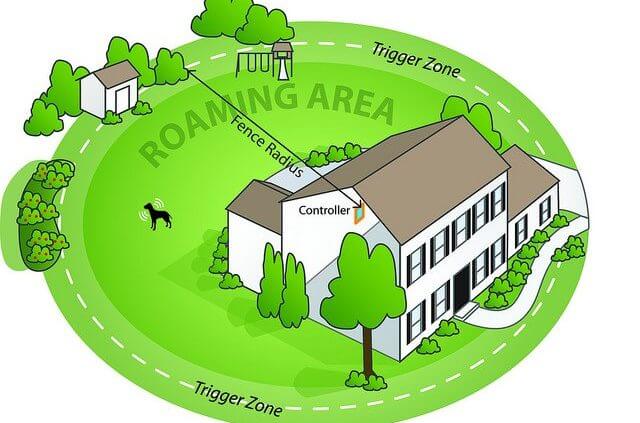Tag Archive for: wireless dog fence
Affordable dog fencing – what are the options?
Affordable dog fencing
When it comes to affordable dog fencing there aren’t many options as fencing is actually quite expensive. As with everything you get what you pay for and it depends on whether you want to get your hands dirty. Naturally, these fencing options are based on how large an area you need to fence. The landscape that you need to fence. And also the breed of the dog that requires the dog fencing!
Dog fencing for small areas
If you are looking to fence a small back garden then it is likely that you already have a fence or wall but it isn’t meeting your needs. Watch your dog and see if he is using something to climb up and scrabble over or is he climbing or digging. Consider installing trellis above your fence. This can be bought from any good DIY store and is relatively quick to install. If you have a digger add a concrete footer below your fence by pouring concrete along the edge of the fence and sinking the bottom of the fence into the concrete before it dries. This is naturally a labour intensive job but should do the trick!
If you are not sure where he is getting out then one of our DIY dog fences is going to be the cheapest way forward. These fences are under £250.00 and will cover a small urban garden. If you compare the price of re-fencing a complete rear garden versus adding an electronic dog fence the dog fence will win on price all day long!
For small gardens with low fences, you may be able to upgrade your fence to a close board fence. These fences start at around £38.00 per metre fully installed. You will need to check that you can install a fence of this height before ripping out the old fence.
Rural gardens and small paddocks
It goes without saying that dog fencing for rural areas can be a headache. Not only are you trying to stop your dog going out but the local wildlife is busy pushing its way in. If you have an issue with rabbits and small dogs then this could be a good option for you but it is not the cheapest! Rabbit fencing starts at approx £130.00 per 50m without installation! If you are covering a 1-acre site this will cost in the region of £690.00 just for the galvanised mesh without any posts of labour. Also unless it is extremely well-installed rabbit fencing can be damaged by larger mammals such as Badgers, Muntjack and larger Deer.
If you have hedges or areas with no existing fences then the cheapest form of fencing will be either a stock fence or an electronic dog fence. If you have horses or livestock then you will need to look at stock fencing options. Of course, if it is only a dog or a cat that needs containing then an electronic dog fence is by far the cheapest option.
Our DIY dog fence can be expanded up to an acre for an additional £100.00 and a Professionally Installed dog fence will cost in the region of £1000.00 depending on the location and number of dogs. This would work out more cost-effective than the galvanized or stock fencing and would also protect the driveways. Installing gates can also be very costly and of course, this relies on people shutting the gate when they come or go! Our Professionally installed fences have a lifetime warranty on the hardware and a containment promise for the dog.
Large estates and difficult terrains
If it aesthetics then Estate fencing is most certainly the winner but you will need deep pockets to install this timeless classic! At around £80.00 per 2m panel + installation, it will very soon add up, especially on the large country estate! Again, you will need to think about gates and this type of fencing is not dog secure. Other popular types of fencing are post and rail with stock fencing below or chain link fencing. Chain link fencing is probably the cheapest starting from around £2500 for 1 acre + installation. Whereas if you are looking at fencing 10 acres using our Performance Series on a 10-acre site the cost would be circa £1800.00 including installation & training.
Riverbanks and Undulating Terrain
If your property goes down to the river you may be able to install a small picket fence. These will not stop all dogs as they tend to only be a 90 cm – 100cm high. Prices for Picket fencing start at around £12.00 per metre plus installation. Alternatively, you can use our dog fence to run along the boundary. This will keep your dog out of the river without disrupting the view. If you have very undulating terrain then you will probably need to install a stock fence but there would be a hefty surge-charge to install this! Again, an invisible fence can be installed for a fraction of the cost. The trencher used to install the invisible dog fence is extremely adaptable and be operated in both steep and undulating terrain. Images of the dog fence trencher can be seen on our installation & training page.
Dog Fencing price summary
Based on an acre (and excluding gates)
-
- Electronic dog fence (1 dog fully installed – covers gateways as well) – from £3.50 per metre installed.
- Stock Fencing (no gates) – from £7.00 per metre installed
- Rabbit Fencing (no gates) – from £8.00 per metre installed
- Stock Fencing with post and rail (no gates) – from £12.00 per metre
- Picket fencing (no gate) – from £20.00 per metre
- Close board fence (no gate) – from £35.00 per metre installed
- Estate fencing (no gate) from £40.00 per metre installed
Prices have been based on submissions from Companies in Berkshire (2019). Prices are based on properties in the local area and are a guide.
If you have been searching for dog fencing options then read our testimonials on our Trust Pilot reviews. If you would like more information or prices call us today on 03450 623623 or complete our quote form.
Containment Fences Explained
What are electronic Containment Fences and how do they work?
Containment fences hit the news earlier this year when the Government declared that they intended to ban e-collars for training dogs.
Sadly, the media jumped in with both feet first and declared that containment fences were also to be banned. At DogFence we were horrified having Professionally installed containment fences for over 17 years we had no idea why! For our customers that already used a containment fence there was outrage. How could the Government even consider banning a fence that had saved their pets life and given them back their freedom? For those that had not heard about containment fences there was intrigue. What is a containment fence and why do they want to ban them?
Even the MP that called for the ban didn’t know if the containment fence was to be included within any ban and the officials at DEFRA did not know how containment fences worked! As experts in the field for containment fencing DogFence were invited to meet with officials from DEFRA and demonstrate the fence.
The comments from the DEFRA team were as we suspected “it’s not that bad” and “it’s not what I imagined”.
So what is a containment fence?
It’s actually an invisible fence or virtual fence which is created by a radio signal. Originally invented to keep dogs safe at home in the USA where gardens are traditionally unfenced their popularity has grown in recent years.
A containment fence is actually a very simple and unobtrusive system which can be installed on virtually any property at a fraction of the cost of traditional fencing. It also offers for safety than conventional fencing as the pet can’t dig under or jump over the fence and it protects open areas such as driveways.
A boundary wire is placed around the property boundary which transmits a coded radio signal to a collar worn by the pet. When the pet approaches the boundary wire a high pitched warning beep alerts the pet to go back. If the pet continues forward, an electrical impulse is given through the collar (this is often referred to as a correction or static shock) and the pet retreats back into the safe area.
How does the pet know where to go?
Every pet undergoes a training programme which usually takes 2 – 5 days. When training to a containment fence it is important that the boundary is flagged to give a good visual of where the virtual fence starts. The flags stay in the ground as a visual marker for approx. 2 – 3 weeks. Containment fences can be used for dogs over the age of 12 weeks and cats 16 weeks or over.
The trainer will take the dog outside and set the collar to “beep only” mode. Using some voice commands, he will introduce the dog to the containment fence training flags and later he will allow the dog to enter the “no go area” of his own accord. By re-focusing the dog back into the safe area with the assistance of the warning beep and vocal commands the pet will quickly learn where he can or can’t go. Following the beep only session the training moves onto to assess the correct level of impulse (correction) required for the pet. If the owner has more than one pet the likelihood is that they will each have a different training level.
With cats the training is carried out internally following the Dog Fence Cat protocol. This training protocol was used as part of the Lincoln Cat Containment Fence study.
Will the containment fence hurt my pet?
Of course the thought of giving any impulse or shock to your pet can be abhorrent. It is important to note though that the impulse is very low and is usually only felt during the training phase. The sad scenario is that the pain felt from a car is almost unimaginable and the discomfort of containment fence is no worse than an annual vaccination. Also for dog owners there is always the threat of a shot gun as dog attacks on sheep are rising annually.
What areas of the garden will the containment fence cover?
Interestingly, containment fences can cover the entire garden including the driveway. The largest installation that we have installed at Dog Fence is 450 acres. Usually the fence wire is dug directly into the ground (approx. 3 – 5” below the surface) but it can be attached to existing physical boundaries. It is not uncommon for the fence wire to be attached to post and rail fences, stone walls, run through hedges, ditches or streams and even the odd moat! When it comes to the driveway any surface can be crossed except Resin bonded drives which require special attention.
Containment Fence Collars
The original containment fences from the early 80’s used heavy bulky collars but as with the mobile phone technology everything has been scaled down in recent years. Not only have the collars become smaller and lighter but the battery life has also increased.
At Dog Fence we can boast the smallest and lightest collars worldwide. Our mini containment fence collar only weighs 30g but still features an incredible 6-month battery life. Incredibly our standard collar has a 2-year battery life and weighs in at only 48g which is still the 3rd lightest collar available worldwide!
How much do containment fences cost?
A containment fence costs a fraction of the cost of installing a traditional fence or driveway gates. Unlike a wooden or stock fence a containment fence becomes more cost effective the larger the area. Naturally the price is dependent on the owner’s location and the number of dog or cats that they have. There is no need to visit a property to give an estimate for the containment fence; this can all be carried out via our online survey tool.
Summary
Thankfully, the Government looked at the evidence, research and responses from containment fence owners and deemed these lifesaving systems safe to use. Indeed, Michael Gove stood up and supported the life-saving fences in Parliament.
If you are interested in receiving a quick free quote contact us today on 01628 476475 or fill in our quote form https://dogfence.co.uk/quote/
Electric dog fences cruel or kind?
Are electric dog fences cruel or kind?
You’ve heard about electric dog fences and are either intrigued, appalled or desperate to know more! Surely an electric dog fence cannot be humane? Why does anyone need electricity to keep a dog in? Electric dog fences, wireless dog fences, containment fences why do I need one?
Dogs are playful, energetic animals with boundless curiosity. Naturally, they require plenty of exercise and are often given the freedom by their owners to roam the garden in the fresh air. However, some dogs choose to push the boundaries of their freedom by attempting to escape. It may be that they are after visiting another dog down the street, a farm, livestock or even next door’s rabbit! All different scenarios necessitating the installation of a good and effective fence to keep the dog safe and at home.
So What are electric dog fences?
Firstly, the name is a red herring. An electric dog fence is not an electric fence. An electric dog fence is actually an electronic fence but is referred to as electric fences. It’s a System that uses a central transmitter which is linked the boundary cable and computer collar worn by the pet.
Electric dog fences generally come in two forms: wired or wireless dog fences. A wired fence is pretty much exactly what it sounds like – a physical perimeter created around your garden by a wire, the route of which is determined by you or the company who installs it.
Types of electric dog fence
Wired dog fences
A wired electric dog fence is relatively quick to install and involves installing a boundary wire around the boundary. Ideally, the wire should be buried a few inches below the ground to avoid damage. The main criteria are that the cable must start and finish at the main base station to complete a circuit.
Wireless dog fences
Wireless dog fences dog not have the flexibility of the wired systems as they are really only suitable for very flat open properties. Wired fences send out a signal from a central base station and create a circular zone around the property. They require a clean line of sight so are not suitable for properties with buildings or trees that will shield the signal. Similarly, properties on steps or slopes are not suitable for wireless dog fences.
Wired electric dog fences are often seen as a more practical than their wireless counterparts as they can extend right to the perimeter of your property, whereas wireless systems have limited reach. You can also dictate the exact shape of the wired electric fence and create ‘out of bounds’ zones for your dog, which is a major bonus.
How does an electric dog fence work to keep the dog in?
The boundary wire acts as an antenna and carries a radio signal around the boundary. The dog or cat wears a small computer receiver collar. A “no go zone” is set around the boundary. As the pet enters the zone the collar wakes up and alerts the pet with a warning beep. If the pet continues further the collar gives out a static impulse. The impulse is harmless and is set by the trainer according to the dog or cats personality, age and breed. It is not a one size fits all but bespoke for each pet.
The question is, however, are these fences humane for your dog?
Are electric dog fences cruel?
Many dog owners make use of electric dog fences on a daily basis and sing their praises from the rooftops! Most owners will “feel” the impulse and agree that the word “electric” is far from the reality. A tingle or static shock would be more akin to the sensation delivered by the dog fence collar. Given the choice of a tingle or being run over or shot owners will attest that a small tingle is the better option. Also, research exists to support the understanding that electric pet fences are humane.
Research into electric dog fences
Animal welfare researchers at the University of Lincoln “found no evidence of long-term welfare problems in cats living with these fences, compared to control cats able to roam freely in and out of their owners’ gardens.” Indeed, researches commented that this was the best option for cats, as indoor cats can be prone to obesity and health issues are more prevalent for cats housed solely indoors. Of course, the statics for cat deaths and injuries speak for themselves.
Electric dog fences are also proven to genuinely train dogs to stay within the boundaries of their property. Dogs are intelligent animals and very quickly (Pavlov theory). They hear the beep and know to avoid the area due to the training. The effect produced by an electric dog fence is similar to a static shock you might receive from a carpet – it’s just enough to distract you, and not enough to cause pain.
Owners Testimonials
Owners point to the positive aspects of electric dog fences, such as their flexibility, effectiveness, and affordable price. The majority of owners who choose to install an electric pet fence are those for whom a physical fence has previously failed. It may be that installing a traditional fence would pose a problem due to planning restrictions or simply cost.
“Some years ago we lost a spaniel hit by a vehicle while chasing a pheasant out of the garden and across the road. The incident caused us and the motorist distress. Had the DogFence been in place we do not believe the incident would have occurred. Furthermore, the DogFence allows us and our dogs to enjoy our home and garden without unsightly, costly and less effective forms of boundary control.”
Our experience is that owners want to keep their pet safe but also give them freedom. Keeping pets indoors, tied up or in a run is far less humane than allowing a pet to roam and display natural behaviour.
How does the pet learn to use the fence?
As part of the installation process, the pet receives professional training. Using some visual markers in conjunction with the warming beep and impulse he quickly learns not to go too close to the boundary. The majority of customer’s report that their pet rarely received so much as a warning beep after their initial training.
Conclusion
If installed and handled correctly, a wired electric dog fence can work wonders in containing your dog. Your pet is kept safe and is able to enjoy plenty of freedom, making it an affordable and humane option. It also provides great peace-of-mind to you, the loving owner. You can rest assured that your pet is safe – no more worrying about them running off, or getting onto the road. With a DogFence system, you get all the benefits of leaving them to roam without the associated worry.
We have solutions for areas of all types and sizes, from small gardens right up to 350-acre estates. There are very few places where we can’t install an electric Dog fence – we can go under pathways and patios, or even over rivers and through woods! It is for this reason that here at DogFence Ltd we only offer installation for wired dog fences as the wireless fences do not offer the safety, reliability or flexibility of the wired versions.
Get in touch today to find out more. 03450 623623 or www.dogfence.co.uk
Ref: University of Lincoln Cat Study:
http://www.lincoln.ac.uk/news/2016/09/1265.asp
Wireless dog fence – the truth – do they work?
Wireless dog fence – is this an easier solution?
What’s the buzz about a wireless dog fence? When considering installing an electronic dog fence one of the factors will be “do I need to install a boundary wire? A wireless dog fence seems like an easy solution. No boundary wire to dig in, just plug in and go! For over 40 years the electronic dog fence has been used to keep pets safe. Traditionally this involved digging or installing a circuit of boundary wire to keep the cat or dog contained. The idea of simply plugging in and going seems so much easier so why are these fences not more popular?
The wireless dog fence involves installing the transmitter into centre of the property. From central transmitter a circular signal creates the no go zone around the garden. Sounds simple enough, however, the downside is that property owner needs to consider several major facts when looking into wireless dog fencing.
Considerations re installing a wireless dog fence
- A Wireless dog fence may not suitable for narrow properties – the property needs to be 30ft wide min.
- Terrain challenges: The lay of the land may not be suitable. A wireless dog fence is not ideal for sloping or terraced gardens.
- Heavily wooded areas can interrupt the signal. Similarly metal objects and fencing can grossly effected the signal leading to dead spots. This happens with all AM electronic dog fences.
- A wireless dog fence collar cannot be worn indoors as is prone to activation from objects within the house – TV’s and dimmer switches as well as other household appliances.
- Fence wobble – the boundary with a wireless dog fence fluctuates so the dog boundary will change causing confusion/danger to the dog .With some systems the Wireless Fence wobble can be up to 16ft.
- A wireless fence cannot be used with houses that have a mobile phone signal booster or smart meter.
- The Wireless dog fence receiver collar is heavy and bulky and not really suitable for small dogs or cats.
- Does not give adequate warning if the pet enters the zone.
The wireless fence does work for some owners. It would be fair to say that this product is probably more suitable to US houses where the house is on an open plan flat plot. For UK households most gardens are already fenced and the wireless dog fence is a backup. With US houses the wireless fence may be the only containment parameter. If the zone does not cover every inch of the property it is not quite so crucial. With a UK garden if the owner has a fence running around the boundary and the installs an interior circular zone this is confusing for the dog.
Also if the owner is prepared to remove the computer collar when the dog enters the house this would make the wireless fence a good option.
Most owners will agree that boundary wobble is unfair for the pet the if the wireless dog fence is being added as a secondary fence it may not be quite such an important issue.
Advantages of a wireless dog fence
- Quick and easy to install.
- No boundary wire to lay – so cable cannot be damaged.
What about wired systems?

The wired fence can be used to cover irregular boundaries even on undulating terrain and can create inner loops to cover pools or play areas.
The advantage that a wired dog fence has over the wireless fence is that it can be used for any shape of property, on any terrain. Also the FM systems* guarantee no false activation on the pets collar both internally and externally so the collar can be worn both inside and outside. Different technology within the wired fences enables the size and weight of the collars to be far smaller and lighter. Collars used for wireless dog fences are heavier and bulkier due to the antenna and batteries.
*Dog Fence UK are the only electronic dog fences worldwide to us an FM signal.
- A wired dog fence can be installed on any terrain and can cover irregular shaped or undulating boundaries.
- If an FM system is used there is guaranteed no false activation on the collar.
- Boundary is consistent – no mixed message for the dog.
- Can cover a larger area – up to 6km of boundary wire (350 acres).
- Collars are smaller and lighter (suitable for all breeds and cats).
- Always gives an audible warning.
Disadvantages of a wired dog fence
- Boundary wire can be broken, therefore, burial of wire is advisable
- Installation will take longer
- Not as easy to move from house to house.
October 2018 Update
Since this blog was originally written the criteria for the installation of both wired dog fences and wireless dog fences has changed in the UK. New Government legislation to be introduced shortly requires that all electronic dog fences need to be professionally installed with training. We are currently waiting for the Governments position regarding wireless dog fences.
Both wireless dog fences and wired systems will contain most pets but it is worth researching before purchasing to avoid making a costly mistake. The training time for both wired and wireless dog fences should be the same and this will be dependent on the size of the area, age and breed of dog.
Should you wish to talk to one of our experts regarding an electronic dog fence installation please call us on 03450 623 623 or email us @ info@dogfence.co.uk. www.dogfence.co.uk.
Articles of Interest?

